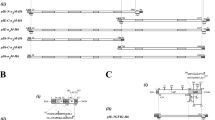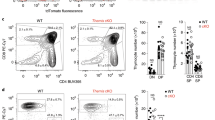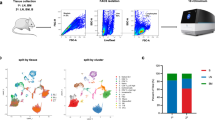Abstract
The human T-cell leukaemia and differentiation antigen HTA 1 is defined by the monoclonal antibody NA1/34 (ref. 1) and also recognized by the monoclonal antibody OKT62. Like class I products of the human major histocompatibility complex, it has a glycosylated heavy (α) chain of approximately 45–50,000 molecular weight (MW) in non-covalent association with β2-microglobulin (β2m) (MW 11,900). A particular feature of HTA 1 is the presence in significant amounts of an additional β2m-like subunit, called βt (refs 3,4). To facilitate biochemical studies we have prepared a high HTA 1 expressor variant (NH17) of the human thymoma line MOLT-45. The N-terminal amino acid sequence of the βt purified from this cell line was shown to be indistinguishable from that of bovine β2m. Further, βt was present when the cells were grown in medium containing fetal calf serum (FCS), but absent from cells grown with human serum (HuS). We show here that addition of human and bovine β2m to MOLT-4 and NH17 cells grown in serum-free medium produces a significant elevation of HTA 1 antigen expression, providing evidence for a regulatory or stabilizing function for the exchange of extracellular β2m with a cell-surface antigen.
This is a preview of subscription content, access via your institution
Access options
Subscribe to this journal
Receive 51 print issues and online access
$199.00 per year
only $3.90 per issue
Buy this article
- Purchase on Springer Link
- Instant access to full article PDF
Prices may be subject to local taxes which are calculated during checkout
Similar content being viewed by others
References
McMichael, A. J. et al. Eur. J. Immun. 9, 205–210 (1979).
Cotner, J., Mashimo, H., Kung, P. C., Goldstein, G. & Strominger, J. L. Proc. natn. Acad. Sci. U.S.A. 78, 3858–3862 (1981).
Ziegler, A. & Milstein, C. Nature 279, 243–244 (1979).
van Agthoven, A. & Terhorst, C. J. Immun. 128, 426–432 (1982).
Burrone, O. R., Calabi, F., Kefford, R. F. & Milstein, C. EMBO J. 2, 1591–1595 (1983).
Calabi, F., Burrone, O. R. & Milstein, C. Molec. Biol. Med. 1, 219–223 (1983).
Brodsky, F. M., Bodmer, W. F. & Parham, P. Eur. J. Immun. 9, 536–545 (1979).
Hyafil, F. & Strominger, J.L. Proc. natn. Acad. Sci. U.S.A. 76, 5834–5838 (1979).
Schmidt, W., Festenstein, H., Ward, P. J. & Sanderson, A. R. Immunogenetics 13, 483–491 (1981).
Sanderson, A. R. & Ward, P. J. Immunology 83, 87–92 (1983).
Lancet, D., Parham, P. & Strominger, J. L. Proc. natn. Acad. Sci U.S.A. 76, 3844–3848 (1979).
Poulik, M. D. & Reisfeld, R. A. in Contemporary Topics in Molecular Immunology Vol 4 (eds. Inman, F. P. & Mandy, W. J.) 157–204 (Plénum, New York, 1975).
Burrone, O. R. & Milstein, C. EMBO J. 1, 345–349 (1982).
Cunnigham, B. A., Wang, J. L., Berggard, I. & Peterson, P. A. Biochemistry 12, 4811–4822 (1973).
Walker, J. E. et al. Eur. J. Biochem 123, 253–260 (1982).
Walker, J. E. & Gay, N. J. Meth. Enzym. 97, 195–218 (1983).
Groves, M. L. & Greenberg, R. J. Biol. Chem. 257, 2619–2626 (1982).
Runswick, M. J. & Walker, J. E. J. Biol. Chem. 258, 3081–3085 (1983).
Author information
Authors and Affiliations
Rights and permissions
About this article
Cite this article
Kefford, R., Calabi, F., Fearnley, I. et al. Serum β2-microglobulin binds to a T-cell differentiation antigen and increases its expression. Nature 308, 641–642 (1984). https://doi.org/10.1038/308641a0
Received:
Accepted:
Issue Date:
DOI: https://doi.org/10.1038/308641a0
This article is cited by
-
Lysozyme and bilirubin bind to ACE and regulate its conformation and shedding
Scientific Reports (2016)
-
Intermolecular complexes between three human CD1 molecules on normal thymus cells
Immunogenetics (1988)
-
Restricted recognition of β2-microglobulin by cytotoxic T lymphocytes
Nature (1986)
-
A novel family of human major histocompatibility complex-related genes not mapping to chromosome 6
Nature (1986)
-
Altered structure of HLA class I heavy chains associated with mouse beta-2 microglobulin
Immunogenetics (1985)
Comments
By submitting a comment you agree to abide by our Terms and Community Guidelines. If you find something abusive or that does not comply with our terms or guidelines please flag it as inappropriate.



